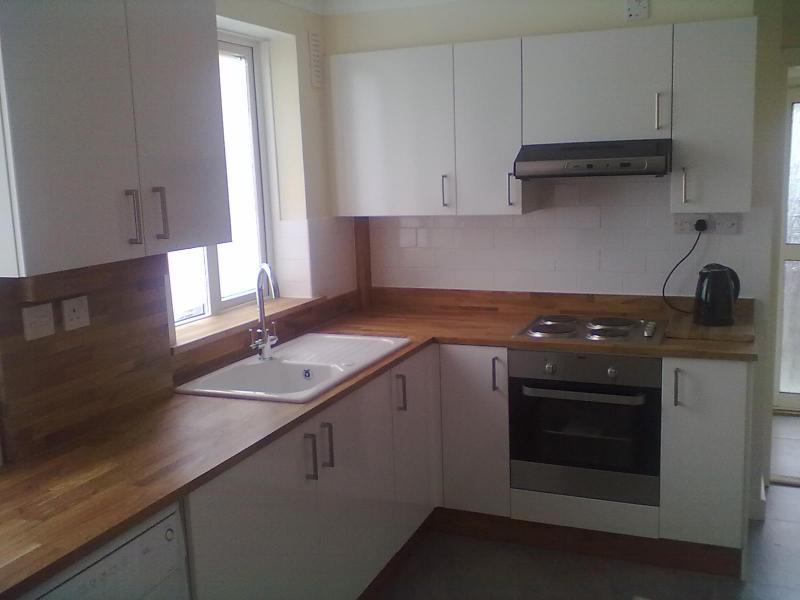Just after some advice please - installing own kitchen. No problems with base & wall carcasses, appliances etc - my main concern is the worktop. I have found plenty of info on this site and others however a lot of it is conflicting. So here is what I know, what I want answers to and what I intend doing:
- I am ok with the correct storage, and number of coats of oil it requires, especially when it comes to edges and cut ends. Is there a particular oil to go for, or is it mainly down to personal preference? Some recommendations have been boiled linseed oil and Ronseal worktop oil. I was thinking of using a light Danish oil. Is this ok to use or far inferior compared to other oils?
- Cutting. I will probably get a lot of hisses here because I know some people are very particular about worktop cutting. This is a solid, square edge worktop and not laminate. It is only 28mm (please no comments I should have got 40mm - there was a £700 difference that we couldn't afford when doing the whole house out!! ) I will be cutting with a decent jigsaw and not a router or circular saw. I am very patient and will be taking my time with the cutting. Any tips please? I was thinking of securing a batten (or jig edge) to the underside to run the jigsaw along to ensure the cut is straight then a fine sand if necessary to ensure it is perfect . Is it best to cut the underside of the worktop (just turn it upside down and do markings that side etc)?
) I will be cutting with a decent jigsaw and not a router or circular saw. I am very patient and will be taking my time with the cutting. Any tips please? I was thinking of securing a batten (or jig edge) to the underside to run the jigsaw along to ensure the cut is straight then a fine sand if necessary to ensure it is perfect . Is it best to cut the underside of the worktop (just turn it upside down and do markings that side etc)?
I don't have a router and will not be looking to purchase one. I wouldn't want a cheap one in any case but at the same time, I don't think I would want to hire one either as I've not used one before and could potentially do more harm than good. The jigsaw on the other hand I am ok with - plus as it is the thinner worktop, I'm guessing it will be easier in any event.
- joining. I will be butting the longer length against the shorter length (the sink would be too close to the join if I did it the other way around). When fixing worktop to carcasses, I will be using shrink/stretch angle plates to allow for expansion and contraction of the wood. I'm also ok with the 5mm gap against walls which will be covered by upstands or tiling. When it comes to fixing the two lumps of wood together there is a lot of conflicting info out there. I propose obtaining flat plates (hopefully stretch and shrink ones too) and fixing together however slacken off for the time being. I would propose then to use a clear anti mould flexible silicone sealant between the lumps and secure the plates tighter. Then neaten up / apply sealant to the join on the top surface.
I understand that worktop bolts are not necessary on solid worktops - only laminate. Is that right? Will the steps above be sufficient / correct?
- I am ok with the correct storage, and number of coats of oil it requires, especially when it comes to edges and cut ends. Is there a particular oil to go for, or is it mainly down to personal preference? Some recommendations have been boiled linseed oil and Ronseal worktop oil. I was thinking of using a light Danish oil. Is this ok to use or far inferior compared to other oils?
- Cutting. I will probably get a lot of hisses here because I know some people are very particular about worktop cutting. This is a solid, square edge worktop and not laminate. It is only 28mm (please no comments I should have got 40mm - there was a £700 difference that we couldn't afford when doing the whole house out!!
I don't have a router and will not be looking to purchase one. I wouldn't want a cheap one in any case but at the same time, I don't think I would want to hire one either as I've not used one before and could potentially do more harm than good. The jigsaw on the other hand I am ok with - plus as it is the thinner worktop, I'm guessing it will be easier in any event.
- joining. I will be butting the longer length against the shorter length (the sink would be too close to the join if I did it the other way around). When fixing worktop to carcasses, I will be using shrink/stretch angle plates to allow for expansion and contraction of the wood. I'm also ok with the 5mm gap against walls which will be covered by upstands or tiling. When it comes to fixing the two lumps of wood together there is a lot of conflicting info out there. I propose obtaining flat plates (hopefully stretch and shrink ones too) and fixing together however slacken off for the time being. I would propose then to use a clear anti mould flexible silicone sealant between the lumps and secure the plates tighter. Then neaten up / apply sealant to the join on the top surface.
I understand that worktop bolts are not necessary on solid worktops - only laminate. Is that right? Will the steps above be sufficient / correct?


